Pest Library: Storage Pests
Concerned you might have storage pests in your pantry? Let us help.
Our experts will identify your pest problem and provide the solution.
Pest Library Pest Library: Stored Product Pests
PEST CONTROL LIBRARY
Stored Product Pests
GRAIN BEETLE
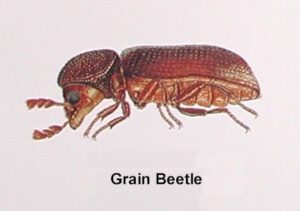
HABITAT/WOOD PREFERENCE
Adults find their way into stored grains, flour, sugar, nuts and other dry material of plant origin through cracks and crevices of imperfectly sealed containers. They are incapable of attacking sound grain kernels and often occur in food previously infested by other stored product pests. This pest may be found infesting dry goods, crawling around kitchen surfaces and occasionally underneath tree bark.
BIOLOGY AND BEHAVIOR
The adult beetle is a small (1/10 inch long), very flattened and brown with the segment just behind the head (pronotum) having characteristic “sawtoothed” outer margins, bearing six “teeth” on each side. Development from egg to egg occurs in 27 to 375 days. Four to six generations can occur annually.
DISTRIBUTION
Worldwide in distribution
SPIDER BEETLE
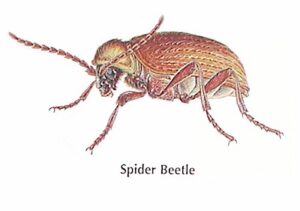
HABITAT/WOOD PREFERENCE
Spider beetles are primarily scavengers with many species feeding on both plant and animal origin materials. They feed on grain products, seeds, dried fruits, meats, fish meal, wool, hair, feathers, skins, drugs, roots, rodent droppings, insect and other animal carcasses, and plant and museum specimens. Besides being founds in human food, warehouses, food-handling establishments, granaries, mills, museums, and homes, they are also found in the nests of bees, wasps, birds, mammals and in vat caves and on dry carrion.
BIOLOGY AND BEHAVIOR
Relatively few eggs, maybe up to 100 but often fewer, are laid in, on or near larval food material. Many species are active only at night, hiding in cracks, crevices, and voids during daylight. Some can fly, others cannot.
DISTRIBUTION
Worldwide but are more common in temperate regions, which includes the U.S.
CONFUSED FLOUR BEETLE
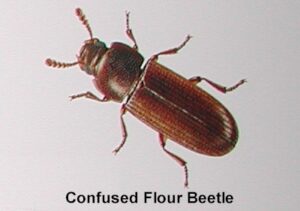
HABITAT/WOOD PREFERENCE
While confused flour beetles cannot feed on whole, undamaged grain, they are often found in large numbers in infested grains, feeding on broken grain, grain dust, and other household food items such as flour, rice, dried fruit, nuts, and beans. Both types of beetles are often found not only in infested grains, but in crevices in pantries and cabinet, as well. Damage to food is caused somewhat by the beetles’ feeding, but also by their dead bodies, fecal pellets, and foul-smelling secretions. In addition to creating a foul odor, the beetles’ presence encourages the growth of mold.
BIOLOGY AND BEHAVIOR
The confused flour beetle female deposits about 300-500 clear-white eggs on or among food materials in cracks, in bags, or through the mesh of sacks containing food. They are attracted to light even though they apparently do not fly.
DISTRIBUTION
Found worldwide in cooler climates and in the U.S. it is more abundant in the northern states
LARDER BEETLE
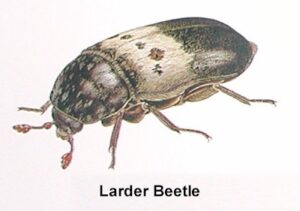
HABITAT/WOOD PREFERENCE
The adults and larvae feed on all kinds of animal products such as dried fish, ham, bacon, meats, cheese, dried pet food, and dried museum specimens including insects, hides, feathers, horn and hair
BIOLOGY AND BEHAVIOR
Adult females lay their eggs on suitable larval food or in cracks and crevices where such food is stored.
DISTRIBUTION
Throughout the U.S. and the world
SAWTOOTHED BEETLE
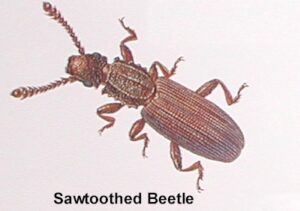
HABITAT/WOOD PREFERENCE
Adults find their way into stored grains, flour, sugar, nuts and other dry material of plant origin through cracks and crevices of imperfectly sealed containers. They are incapable of attacking sound grain kernels and often occur in food previously infested by other stored product pests. This pest may be found infesting dry goods, crawling around kitchen surfaces and occasionally underneath tree bark.
BIOLOGY AND BEHAVIOR
The adult beetle is a small (1/10 inch long), very flattened and brown with the segment just behind the head (pronotum) having characteristic “sawtoothed” outer margins, bearing six “teeth” on each side. Development from egg to egg occurs in 27 to 375 days. Four to six generations can occur annually.
DISTRIBUTION
Worldwide in distribution
RICE WEEVIL
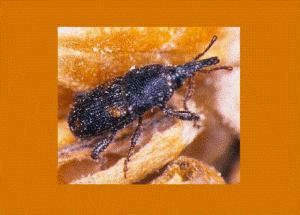
HABITAT/WOOD PREFERENCE
Since the larvae are subterranean, they are rarely seen. Adults are typically nocturnal and remain concealed on the plant or in the litter or soil during the daytime. All weevils will enter structures when conditions outdoors become adverse.
BIOLOGY AND BEHAVIOR
They mostly spend the winter as almost-mature larvae in the soil among the host plant’s roots. They pupate in the spring near the soil surface. Adults emerge from early May to late July.
DISTRIBUTION
Found throughout most of the U.S. and Canada
